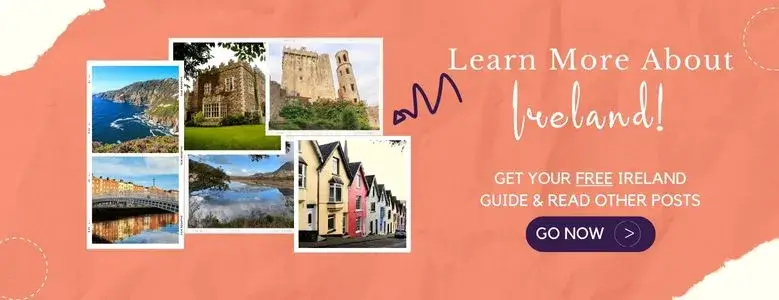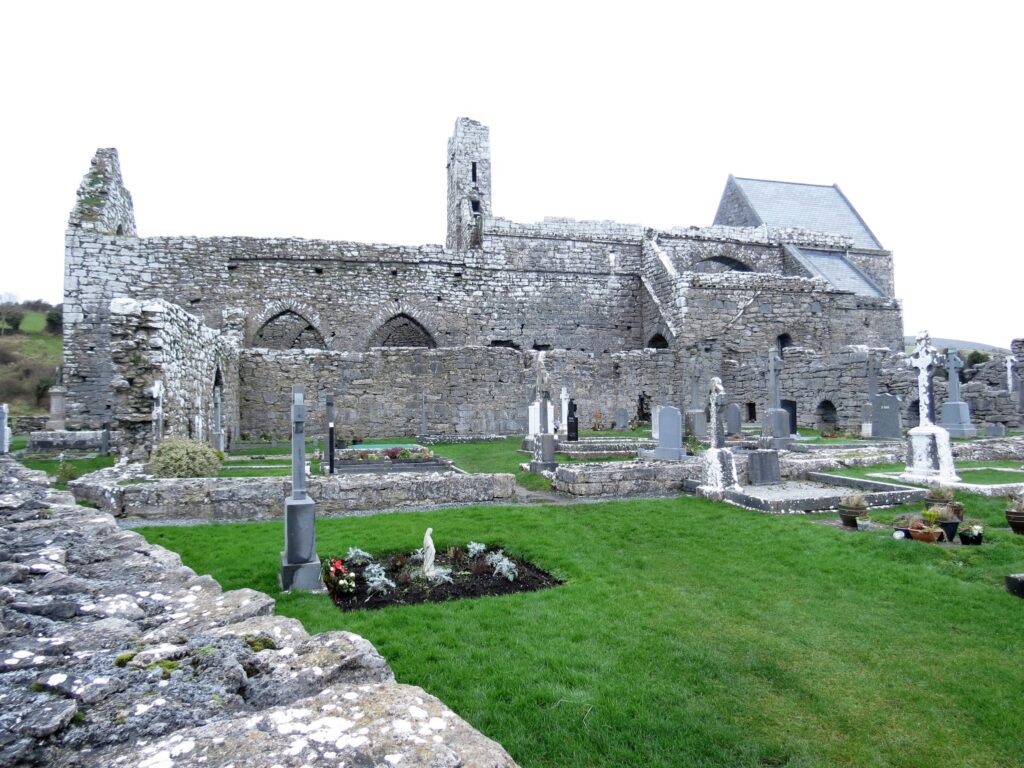Ireland is a great destination for any type of vacation – renting a house, doing a guided tour, solo or group travel, or a road trip! Renting a car and driving in Ireland is a great way to get off the beaten path and see more of the breathtaking country. Driving gives you more independence and freedom in your itinerary. From the capital city of Dublin, to the awesome small towns in Ireland, you’ll find incredible gems around the country.
If you like this post, be sure to sign up for my e-mail list for travel inspiration (and get your FREE budget printable), or connect with me on Facebook, Instagram, Twitter, or Pinterest.
This post contains affiliate links. Meaning if you buy something, I may make a small commission at no cost to you.


Tips for Driving in Ireland: Before you go
- Get an international drivers’ permit. While it’s not required by law, many rental companies do. Save yourself the headache and get one. You can get one for about $25 at your local AAA office. There is no test required, it’s just a translation of your valid driver’s license. Make sure that your license is valid for at least six months after your trip.
- Be sure about the transmission you choose. In Europe, a manual transmission is very common. If you can’t drive a manual, be sure to rent an automatic.

Travel Tip: Even if you can drive stick shift, can you drive it with both hands? Since you drive on the left side of the road, you’ll have to use your other hand!
- Get mentally prepared to drive on the left side. It’s a change – trust me. Even once you think you have the hang of it, you may find yourself drifting to the other side (I cannot confirm or deny that I did this…) Starting out, there’s no shame in putting on your flashers and taking it slow.
- Learn about roundabouts and how to navigate them BEFORE your trip. Instead of traffic lights or entrance/exits on highways, Ireland has roundabouts. Even if you’re familiar with them (Jersey girl here), in Ireland you go to the left (counterclockwise) instead of to the right (clockwise). One of the best things about roundabouts is if you miss your turn, you just keep going around until you see it again! Also – people IN the roundabout have the right of way.

Tips for Driving in Ireland: Getting Ready to Hit the Road
- 5. Be prepared for motion sickness (or car sickness). Once you’re out of the cities, the roads are narrow, curvy, and hilly! So if you’re prone to motion sickness, take your Dramamine or other medication before you start on a long road trip. This is probably the most important tip for driving in Ireland. If you’re not prone to it, but feel it anyway, try to look at the horizon or even take a break at a pub or go for a walk. Here are some tips for avoiding motion sickness while traveling!

Travel Tip: When renting a car anywhere – take a video of the car when you pick it up. Get the entire car in the video to show what it looks like and document any damage or scratches. Do this again when you drop it off. This way you’ll have evidence to dispute any damage charges. This could save you a lot of money.
- 6. Don’t freak out about the road signs. The road signs are bilingual! This is one of the reasons why driving in Ireland is easy for Americans. Gaelic is at the top, English is on the bottom.
- 7. Don’t rent a huge vehicle. While having the extra room in your car is nice, you don’t want a very large car. When I say the roads are narrow, I mean it. Many country roads (read: the majority) are one lane meaning you have a small pull-off to let other drivers through. Avoid the headache of navigating these in a large SUV.
- 8. Be sure to have rental insurance for the car. Even if you’re the safest driver in the world, other drivers aren’t. Having travel insurance will give you peace of mind in case something happens.
Travel Tip: Check your credit card to see if it covers rental cars. Many of them include this if you rent the car with the card.

Tips for Driving in Ireland: On the Road

- 9. Fill up often! A lot of Ireland is rural countryside – add in potential sheep herds and the occasional wrong turn – you could run out of gas easily. Running out of gas on the side of the road is bad enough – but add a few hours of waiting for another car to pass is just miserable. If you’re coming from America, it’s important to note that the green pumps are gasoline and the black are diesel (which is opposite from our pumps). Also, not all gas pumps stop automatically when the tank is full so don’t leave it on its own and expect it to stop!
- 10. Leave the navigation to the passengers. Unless you’re a solo traveler, be sure to hand over the navigation to someone else. While there are plenty of signs, they are often right in front of the turn – meaning you won’t have a safe distance to read, think, then turn if necessary. Smaller roads won’t even have signs and the road numbers are tiny – so take the pressure off and let someone else do the navigator.

Travel Tip: Laugh at your mistakes. Trust me. Driving is stressful, navigating is stressful. There will be mistakes.
- Don’t be afraid to go slow. Look, it’s a new country, new roads, driving on a different side of the road, a new car, just take your time. The Irish are some of the friendliest people in the world, I don’t think I ever heard a honk or saw a dirty look. If you’re nervous about that, just put your flashers on and pull over. (Though chances are they’ll pull over and see if you need help – they’re THAT nice!)
- Be aware of drivers with L or N on their back window. This is something I wish we had in America. The L sticker shows that this person does not have a license, but is learning to drive. The N means newly licensed driver. The indicators are for other drivers to give them additional space (and patience!)


- 13. Speaking of letters, there are five different “types” of roads in Ireland – M, M with tolls, N, R, and L.
- M are multi-lane freeways that can handle a LOT of traffic. Some of those will be toll roads – mostly in the area around Dublin. They take a picture of your car license as you pass through the purple toll gate. You either pay when you return your car rental or on the app. Sometimes, a little further out of the city there are cash only tolls – they cost around 2 euro.
- N is for National roads that aren’t as large as the motorways but connect bigger towns (such as Doolin and Dingle).
- Regional roads (R ) are a bit smaller and have more trucks and tractors on them (the Dingle Peninsula is filled with regional roads.)
- Finally, the local roads (L) are dotted with tractors, farms, and sheep. Don’t skip them just because they’re not highways – they’re worth the time!
- 14. Be prepared for anything on the road. I mean anything. Sure, there’s other drivers and bikes, but there could also be sheep and cows walking along as well. Sometimes there’s a farmer, sometimes there’s not. There may even be a farmer controlling them or a guy getting out of his truck to try to get the cows back in the fence for his neighbor (true story).

Travel Tip: If you need emergency services in Ireland, the number is 999!
- Don’t be afraid to pull over for sights. There are plenty of sights to see around the countryside including castle ruins – so feel free to pull over and park for a break!
Read More about Ireland
15+ Must-Visit Castles in Ireland
10+ Best Small Towns in Ireland
60+ Best Things to do in Ireland
Pin “Tips for Driving in Ireland” for later!



Haha! As a Brit this was great to read! My partner did a motorbike road trip about Ireland a few years ago and I would love to do it with him in a car. In America we had some of the opposite issues like using an automatic, driving on the right and the fact there are almost no roundabouts?!
I already knew about the driving on the left side but nothing about the manual being the preferred transmission. Thanks I’ll definitely have to keep this in mind.
Haha there’s always something else to remember. We actually forgot that the left side meant that you’d have to use your left hand with a manual transmission, where in the USA you’d use your right. So it’d still be different! haha
This is so detailed and helpful. I can’t think of anything you miss but I do wish I had read this years ago!
Glad you thought so! Thanks for reading.
Great advice!
Although, the “go slow” should also include be ready to pull over when speedy locals are right behind you. I used to live in the West of Ireland (with crazy windy country roads- they are actually waaaay better now!) My dad would always pull to the side and let cars past if we were going slowly to admire the views.
Oh, and be extra careful at night. There can be a maddening amount of drunk driving. 🙁
Oh absolutely! I”ll add that to the post. Thank you!!!
This is not true. There is not a maddening amount of drunk driving at night in Ireland. I’m Irish, born and bred and what you refer to hasn’t existed since the 1970s or 80s..maybe at latest the 90s. There are severe penalties for drink driving and people don’t do it anymore! Sure, there might be an occasional isolated case, but on the whole, there’s very little drink driving in Ireland now. Look up our official road statistics on RSA.ie as proof.
That’s awesome to note! I was going to add about the pulling over for sightseeing, but I can make a note of that as well. Thank you for your comment!!
These are awesome tips! I know I would have a hard time driving on the left side of the road, but its good to know that the signs are also in English. Can’t wait until I am able to take an Ireland road trip!
Thank you for all the helpful tips! I’ve always wanted to come to Ireland, so this is definitely helpful!
Ireland is such a beautiful country and I think a road trip would be the perfect way to discover it.
All that greenery just looks so calming! And all the sheep! How have I never been to Ireland already…..!
This is so helpful! I don’t see enough tips about driving in other countries, especially for us used to driving on the right side of the road haha 😛
I would love to visit Ireland. It looks so serene. The only problem is that I’m not driving and I’ve heard that you cannot go to some places without a car. I had to plan my route accordingly. But anyway, certainly worth the effort.
These are great tips! I love driving in the countries I visit – mostly for the freedom it gives me, but I feel like I also get to see the country from a different viewpoint when I have to navigate for myself! I should probably learn how to drive manual haha!
I’m not sure that I would be driving anywhere where you drive on the left side of the road, but im sure you get use to it eventually. I am old enough to know how to drive a manual, but it would have nevet dawned on me that it too was with your left hand. Very interesting and informative post.
Haha that’s fair! It didn’t dawn on us until we got to Scotland that the manual was on the other side (luckily we had automatic so I could drive as well). It’s definitely an adjustment on the left side and I did find myself on the right side a time or two. Luckily we have so many options to get us places without driving.
This is a great list of driving tips. I learnt driving on manual in a country with primarily broad city roads where we drive on the left side, and now live in a country with narrow lanes where we drive on the right side and we drive an automatic now. So I could relate to most of your tips and remembered many fun confusions from the past. By the way, Ireland looks so pretty. 🙂
Haha I tried to learn manual and failed, but now my husband has an automatic so it’s all good now but it was quite the adventure haha. 🙂 Ireland is beautiful and hopefully you’ll see it in person.
This is a very cool post! I think he will help a lot, I agree that the main thing is not to panic and calmly go on the left side. Good luck to all!
Absolutely!
Looks like an unpolluted country to me! But just that the road seem steep!
Great information! There are lots of things there we would have never thought of or known about.
Pingback: Two Days in Galway
Pingback: The Ultimate Ireland Bucket List
Pingback: Ireland Road Trip Planner: The Perfect Budget Itinerary
Pingback: European Road Trips That Should Be On Your Bucket List
Amazing! I know nothing about traveling all over the country, what a wonderful looking place to explore.